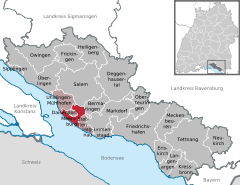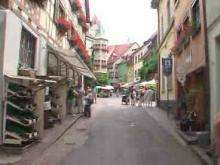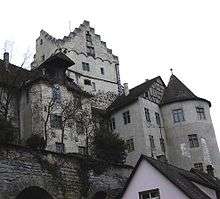Meersburg
| Meersburg | ||
|---|---|---|
 | ||
| ||
 Meersburg | ||
Location of Meersburg within Bodenseekreis district 
 | ||
| Coordinates: 47°42′N 9°16′E / 47.700°N 9.267°ECoordinates: 47°42′N 9°16′E / 47.700°N 9.267°E | ||
| Country | Germany | |
| State | Baden-Württemberg | |
| Admin. region | Tübingen | |
| District | Bodenseekreis | |
| Municipal assoc. | Meersburg | |
| Government | ||
| • Mayor | Martin Brütsch (/) | |
| Area | ||
| • Total | 12.08 km2 (4.66 sq mi) | |
| Population (2015-12-31)[1] | ||
| • Total | 5,776 | |
| • Density | 480/km2 (1,200/sq mi) | |
| Time zone | CET/CEST (UTC+1/+2) | |
| Postal codes | 88709 | |
| Dialling codes | 07532 | |
| Vehicle registration | FN | |
| Website | www.meersburg.de | |
Meersburg (Low Alemannic: Meerschburg) is a town of Baden-Württemberg in the southwest of Germany at Lake Constance.


It is known for its medieval city. The lower town ("Unterstadt") and upper town ("Oberstadt") are reserved for pedestrians only and connected by two stairways and a steep street ("Steigstrasse").
History
The name of the town means "Castle on the Sea", the former referring to the castle which, according to a tradition from 1548, was built here in 630 by the Merovingian king Dagobert I.
The commune obtained the status of free city in 1299, though nominally still under the Bishop of Constance. In 1803 it was annexed to the Land of Baden.
After World War II, Meersburg remained in the French military occupation area in Germany.
Main sights
The town is home to two castles, the Old Castle and the New Castle. The Old Castle, built by Merovingian King Dagobert I in the 7th century, accepts visitors. A self-guided tour is available. German poet Annette von Droste-Hülshoff lived there for eight years. The New Castle was built in the 18th century. Originally the residence of the Bishop of Constance, it was used for various purposes after the Secularization of 1803. It is now a museum.
There is an entity of Half-timber houses.
Also two medieval town-gates can be seen, which are the remainders of the fortification.
Transportation
Meersburg is the northern terminus of a car ferry to Constance. At the opposite side Meersburg is connected to the region by the B 31, a large roadway which leads from Breisach (at the French border) to Lindau (at the Austrian border), bypassing largely all parts of Meersburg. To exit to Meersburg and to the car ferry, take B 33 to Meersburg and Constance.
Meersburg is also reachable by pleasure boats from Lake Constance to Überlingen (westwards), to Lindau, Bregenz (eastwards) and to Constance opposite.
Famous people

One of Germany's most celebrated poets, Annette von Droste-Hülshoff, lived her final years at Meersburg Castle, from 1841–1848. She also owned the small vine-covered villa known as Fürstenhäusle.[2]
The famous 18th-century doctor Franz Anton Mesmer (from whose name the verb "to mesmerize" derives) died in 1815 in Meersburg and is buried near the old wall of the graveyard about 0.5 kilometres (0.3 miles) northeast of the upper town-gate "Obertor" (see picture beneath).
Viticulture
The Meersburg vineyards at the northern banks of Lake Constance are famous within Germany. The rosée "Weissherbst" wine is a specialty of the region.
International relations
Meersburg is twinned with:
-
 Hohnstein, Saxony, Germany – since 1991
Hohnstein, Saxony, Germany – since 1991 -
 Louveciennes, France – since 1991
Louveciennes, France – since 1991 -
 San Gimignano, Italy – since 2002
San Gimignano, Italy – since 2002
Gallery
 Old castle of Meersburg.
Old castle of Meersburg. Half-timbered water mill, now private house near the Altes Schloss, Meersburg.
Half-timbered water mill, now private house near the Altes Schloss, Meersburg. Franz Anton Mesmers' gravestone in Meersburg.
Franz Anton Mesmers' gravestone in Meersburg. View of the centre of the upper town.
View of the centre of the upper town.
References
External links
| Wikimedia Commons has media related to Meersburg. |
- The official Meersburg homepage
- Meersburg-Webcam: 2 livecams show the historical marketplace
- Meersburg: history and images (in German)
- Meersburg: Pictures
